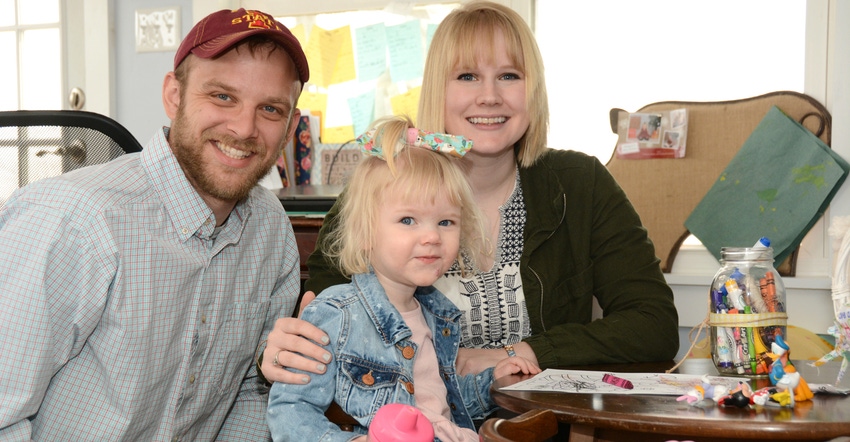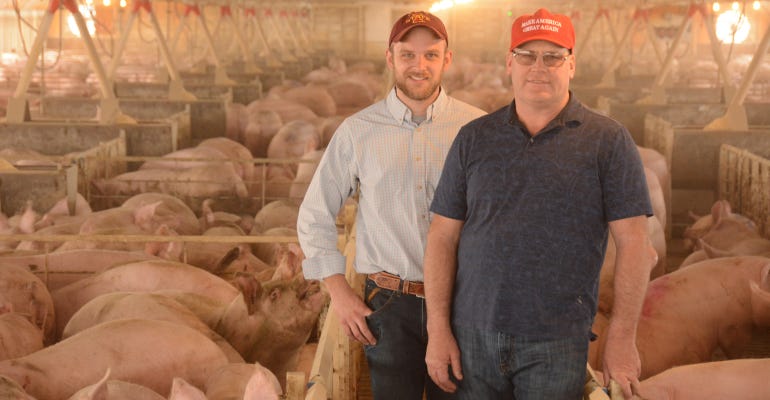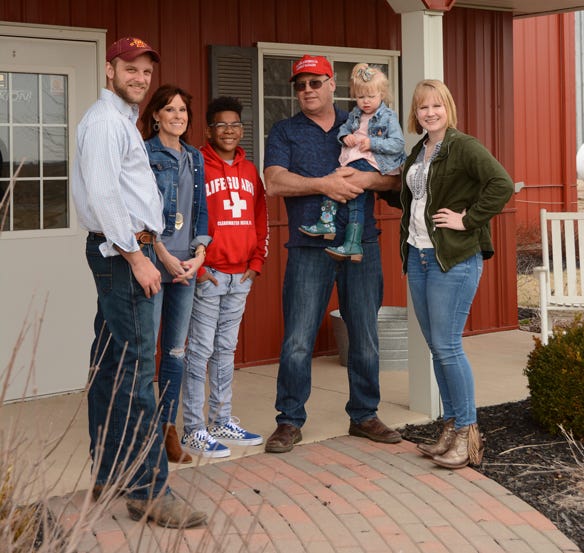
In less than five years, young farmers Cameron and Donna Klostermann graduated from college, got married, lived and worked in another state, started a family, remodeled a farmhouse, and moved back to the family farm. They’ve worked full time off the farm and part time on the farm, and then full time on the farm and part time off the farm.
These are the days of transitions, to put it lightly.
“It was always the goal to come back to the farm,” Donna says. And in many ways, nearly every decision they’ve made since they met — and maybe even before — has led them back to the family farm with her parents, Harry and Dee McCune, near Sheffield, Ill.
“We used to joke, the prerequisite to date me was, ‘Are you from a farm and are you willing to move to western Illinois?’” Donna says, laughing. Their match at Iowa State University may well have been made in heaven, as Cameron grew up on a farm near Dyersville, Iowa, but always knew there wouldn’t be room for him there with limited acreage and a father who was one of nine children.
After their graduations, the couple married and moved to Kentucky, where Donna worked as a grain merchandiser at Consolidate Grain and Barge in Uniontown.
“We lived in a trailer down by the river in Kentucky — all the stereotypes!” Donna quips. They loved Kentucky, though, and made it their early home, with Cameron working at a local co-op.
Within a year, both had opportunities back in Illinois, to work with her family’s grain business, Michlig Grain. Donna bought grain at the Bradford location and Cameron headed up operations at Sheffield. Meanwhile, in addition to raising corn and soybeans on 4,000 acres, Donna’s parents built two hog confinement buildings, with space to feed 5,000 hogs wean-to-finish on contract for JBS.
Today, Cameron works full time on the farm, managing inputs and land with Donna’s dad and heading up the hog operation.

BACON: Harry McCune says he built the hog barns without knowing 100% that Cameron and Donna would come back to the farm — but he knew their 5,000-head capacity would be of a scale that would always have value to someone. The barns are powered by solar panels just outside the facilities.

All the benefits
“Being on the farm offered more flexibility,” Cameron says, pointing out that it gives him more time with their growing family, including daughter Caroline, now 2 years old. “I don’t have to leave at 4 a.m. to check the dryer and oversee employees anymore.”
Donna, meanwhile, is transitioning out of full-time employment and engaging more fully with the farm these days. About a year ago, she went to part time as a grain originator and primarily works from home — with a desk right next to Caroline’s coloring table. On the farm, she’s responsible for their grain marketing. Her mom, Dee, has essentially served as chief financial officer for their farm and associated businesses, including Michlig Ag and Florida properties, and she’s starting to teach Donna her ways and hand over some of those responsibilities.
As much as he loves being back on the farm, Cameron is grateful for the time he and Donna had away. “When you work for people who aren’t family, you learn to work with different personality types,” he says.
Donna concurs. “I wouldn’t be as sharp selling our grain if I hadn’t done it for someone else for three years.”

FAMILY: Just outside the farm office for McCune Farms, the family circles up. Cameron Klostermann (left) stands with his mother-in-law, Dee McCune, and her nephew Noah, as Harry McCune holds young Caroline next to Donna Klostermann.

Cameron and Donna are part of the Cultivating Master Farmers Class of 2019, a two-year farmer mentorship group that puts a select group of young farmers in the same room to learn with Master Farmers. CMF is sponsored by Prairie Farmer, Growmark, Illinois Farm Bureau, Bayer, Farm Credit Illinois and Compeer Financial. They’ll graduate in July, as another class kicks off.
As for what the Klostermanns have learned during their transitions?
“A good barometer for success is what you’ve built, but you don’t want to squander what your family has built. If we can make the operation more efficient, that’s something we can bring to the table,” Donna says.
Transitioning the land
Donna’s father, Harry, is also a pilot and compares a lot of farm management decisions to preparing for an engine outage.
“Nothing is guaranteed in life. You have to be prepared,” he says. Part of their preparation includes transitioning 300 acres to organic grain production.
“How do you differentiate from everybody else? You can only sharpen the sword so much,” Harry explains. They’ll start with 160 acres in 2019. Harry looks hard at their average gross and is comfortable with what they can make with a limited number of organic acres versus adding ground that’s not available.
“We’re looking at an average gross of $1,400 an acre. I’d have to add 2,000 acres to gross that. Where do I find those acres? How far would I have to travel?” he asks.
They can also leverage their hog manure on organic acres. Cameron says their barns typically produce enough to cover 100% of their nitrogen, phosphorus and potassium needs on 240 acres of corn.
About the Author(s)
You May Also Like






